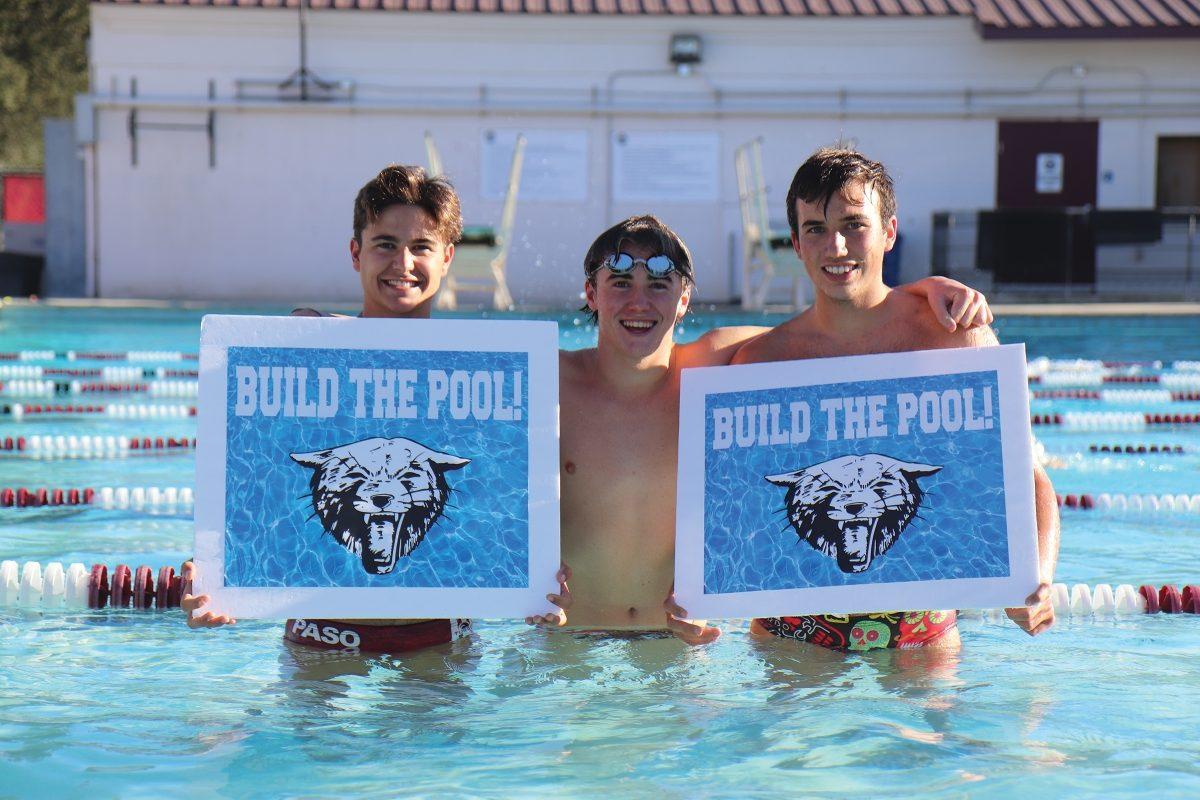Issues with current pool force district to take action towards building new pool
Measure M: it was the decision of voters during the 2016 election. Involved in the new measure was a plan for financial aid to help build a brand new, on campus pool at PRHS. For decades, swimmers at Paso Robles High School have been forced to travel off campus every single day to the local Municipal Pool. With high traffic, long travel distances, and other delays, it has been difficult for swim athletes to make the trip every day. Alongside that, issues with pool have been plaguing players forever. Between breakdowns which last for days, overlapping canceled practices due to city events, and the lack of ability to host home meets due to the shallow deep nature, swimmers have been struggling to perform their best.
Parents, players, coaches, and the community alike made their way to the district office on Mar. 8 to show their support. Athletes, both current and former, had shown up to give their opinions towards the board. Bearcat alumni Zach Tucker, a former water polo and swim athlete, did just that, pointing out to the school board the difficulties of the Municipal Pool to give players a fair chance at college opportunities over that of a full, on campus, all deep water pool.
“What I didn’t realize at the time was that I was inadequately training in a non-regulation pool,” Tucker said during his speech. “When I arrived at Cuesta, my teammates all came from schools that had regulation pools and thus had a total advantage over me with their prior training. I feel like a lack of an all deep regulation size pool has handicapped our aquatic athletes.”
The Municipal Pool is known as a non-regulation pool, meaning it does not meet the standards of USA Water Polo (USAWP). According to USAWP, “A standard (championship) course is 30m x 20m for men and 25m x 20m for women. The depth should be at least 1.8m.” The current pool is only 25m x 15m, and only half the pool lies below 1.8m of depth, with the other half being shallow enough, players can stand on the bottom during gameplay. It is also because of this failure to meet regulations, that Paso is not allowed to host home water polo games for CIF, or host home swim meets due to the shallow nature of the pool posing a risk to swimmers diving in off of the blocks.
“Our pool is shallow-deep which is not regulation,” Collin Moore said. Moore is the head coach of the boys aquatics programs at PRHS. “Most teams won’t travel to our pool unless they have to. Our pool is insufficient for what the league requires, and we have to travel to the other teams pools to go to meets even though we were originally designated as the host team.”
We can only swim a four lane meet, and because of that, its insufficient for
what the league requires.
any other teams that
we try and add matches
against will never travel
to our pool

Similar risks can be found in the pool due to lack of recent repairs. During the entire week of Feb. 14, the Municipal Pool faced a broken pump, a simple fix that the athletes assumed would be fixed by the next day. With the first meet on that Friday, the team had to prepare for it, and without a pool, it would be hard to do so. Alongside that, cracks can be found all throughout the pool, which has led to some injuries during games which provides a huge risk to player safety.
“Our team captain, Cody Domingos, had sliced open his foot on a broken tile during a game against Righetti,” junior Nolan Severson said during his speech at the board meeting. “Jakob [Baier] and I had to put a piece of gum over the tile in an attempt to prevent similar injuries in the future.”
Another safety risk involved with an off campus pool is transportation, an issue which has plagued athletes ever since the first use of Municipal Pool. Many players are involved in increase risk of accident while rushing out of the campus parking lot and across town to the pool. Some players may not even have rides to practice some days, as parents could still be working and no other ride option is available for them.
“A lot of it is safety in terms of transportation for students,” Moore said. “Some students still need to drive their own personal vehicles to go across town after school, and that has created some safety issues with students driving more than necessary. They have to get across town in a pretty rushed manner to arrive before their practice starts.”
The new plan, as decided at the board meeting on Mar 8, sets out to build the pool and end up benefiting the athletes and community a lot better than the previous plan, while also saving the district money, which was a large problem from the previous plan. While not the same idea as what was promised with the original Measure M, this route would end up bringing the pool to the athletes a lot sooner, and a lot more in the budget than previous estimates. The new plan involves building a singular 39 meter pool, such as that found at San Luis Obispo or Arroyo Grande, and selling off all the excess parts that are no longer needed. If approved, the pool could be finished as early as April 2023, and the first full season of water polo can be played in it as early as Fall of 2023.
These are just rough estimates, as of now, though. Currently, the project has yet to be finalized by the board, mostly due to legal issues. As of now, it is unknown whether the 39 meter pool will be able to be approved, or whether the school will be forced to build the original plan as laid out in Measure M. This situation is currently under review by an attorney, and will end up being solved at a later date.
“Municipal is much smaller, older, and insufficient compared to the needs of the program,” Moore said. “It really harms our competition of other teams [with regulation pools] in our league at the moment.”








